- Welcome
- Features
- Use Case
- Introduction
- Working with CCR
- Basic navigation and usage tips
-
Working with patients
- Working with patients
- Searching for a patient
- Looking up a patient with an MRN
- Using the Quick Search Utility to search for a patient
- Performing an advanced search
- Performing a search with criteria based on study or cancer group specific attributes
- Restrictions on searches
- Adding a patient
- Adding a patient who has never been a UUHSC patient
- Removing a patient record from a cancer group database
- Viewing/editing a patient record
- Marking a patient record ready for review
- Viewing/editing the demographic information of a patient who has never been a UUHSC patient
- Viewing a patient's clinic visit patient review page
- Providers
- Treatment protocols
- Diagnoses and staging
- Tumors
- Race
- Patient classifications
- Aliases
- Cancer group studies administration
- Patient contacts
-
Studies and study enrollment
- Studies
- Viewing/editing study-specific data for a patient
- Viewing/editing a patient's enrollment in a study
- Study enrollment
- Enrolling a patient in a study
- Removing a patient from a study
- Viewing/editing a patient's enrollment in a study from the patient detail window
- Patient consents
- Patient consents (study enrollment window)
- Recording a patient consents
- Recording a patient consents (study enrollment window)
- Deleting a patient consent record
- Deleting a patient consent record (study enrollment window)
- Editing a patient consent record
- Editing a patient consent record (study enrollment window)
- Scanned consent forms
- Scanned consent forms (study enrollment window)
- Uploading a scanned consent form
- Uploading a scanned consent form (study enrollment window)
- Removing a scanned consent form
- Removing a scanned consent form (study enrollment window)
- Viewing a previously uploaded consent form
- Viewing a previously uploaded consent form (study enrollment window)
-
Specimens
- Specimens
- Adding a specimen to a patient record
- Linking a specimen from itBioPath to a patient record
- Removing a specimen from a patient record
- Viewing/editing a specimen in a patient record
- Accessing a specimen's itBioPath record
- Recording an alias for a specimen
- Deleting a specimen alias
- Editing a specimen alias
- Linking a previously unlinked specimen to an itBioPath record
- Specimens associated with a medical event
- Linking a medical event to an existing specimen in the patient record
- Adding a specimen to a medical event
- Linking a specimen from itBioPath to a medical event
- Removing a specimen from a medical event
- Viewing/editing a specimen that is associated with a medical event
-
Lab tests
- Lab tests
- Setting up a lab test type to be automatically imported into the patient records of a cancer group
- Adding lab rest results to a patient record
- Reviewing a patient's UUHSC lab test records for importing into CCR
- Deleting a lab test result from a patient record
- Viewing/editing a lab test result
- Lab tests associated with a medical event
- Adding lab test results to a medical event
- Linking a medical event to a previously entered lab test result record
- Adding a lab test result to a medical event and a patient record at the same time
- Removing a lab test result from a medical event
- Viewing/editing a lab test result that is associated with a medical event
-
Medical events
- Medical events
- Adding a medical event to a patient record
- Removing a medical event to a patient record
- Viewing/editing a medical event
- Tools to facilitate medical event data entry
- Associated medical events
- Associating a medical event with other medical events
- Removing a medical event's association with another medical event
- CPT codes
- Adding a CPT code to a medical event
- Removing a CPT code to a medical event
- Medical event classification
- Assigning a classification to a medical event
- Removing a classification from a medical event
-
Chemo and systemic therapy events
- Chemo and systemic therapy events
- Therapy agents
- Entering the default agents for a specific therapy regimen
- Adding a therapy agent to a chemotherapy medical event record
- Removing a therapy agent from a chemotherapy medical event record
- Resetting therapy agents and dosages to match the default values for a selected regimen
- Editing a therapy agent record in a chemotherapy medical event
- Chemotherapy adverse events
- Adding an adverse event record to a chemotherapy medical event
- Removing an adverse event record to a chemotherapy medical event
- Editing an adverse event in a chemotherapy medical event
-
Radiation therapy events
- Radiation therapy events
- Treatment summaries
- Adding a radiation therapy sequence to a radiation therapy medical event
- Deleting a radiation therapy sequence to a radiation therapy medical event
- Editing a radiation therapy sequence in a radiation therapy medical event
- Radiation therapy adverse events
- Adding an adverse event record to a radiation therapy medical event
- Deleting an adverse event record from a radiation therapy medical event
- Editing an adverse event record for a radiation therapy medical event
-
Imaging events
- Imaging events
- Images
- Adding an image to an imaging event
- Uploading an image from an imaging event
- Adding an image to an imaging event without uploading it
- Viewing an image from an imaging event
- Deleting an image from an imaging event
- Editing the description of an image
- Findings
- Adding a finding from an imaging event
- Deleting a finding from an imaging event
- Editing a finding from an imaging event
-
Enterprise data warehouse and tumor registry records
- ITS Enterprise Data Warehouse
- Linking an encounter (medical event) from the Enterprise Data Warehouse to a patient record
- Linking a previously unlinked medical event record to an EDW encounter
- Importing a lab test result from the EDW into a medical event and a patient record at the same time
- Performing a text search of EDW records using keywords associated with a medical event type
- Performing a text search of EDW records using keywords associated with pathology reports
- Performing a text search in an EDW report using a keyword that has not been automatically generated
- Refining the list of EDW reports included in a text search
- Reviewing a patient's UUHSC encounter and clinical records for medical events to add to their CCR record
- Viewing a patient's EDW records
- Viewing a patient's EDW records from within a pathology report record
- Viewing the details of a UUHSC clinical record
- Finding a UUHSC encounter for a patient in EDW
- Viewing a patient's tumor registry records
- Viewing the details of a UUHSC encounter
-
Pathology reports
- Pathology reports
- Adding a pathology report to a medical event
- Linking an existing pathology report to a medical event
- Adding a new (not previously existing) pathology report to a medical event
- Removing a pathology report from a medical event
- Viewing/editing a pathology report
- Tools to facilitate pathology report data entry
-
Using the Patient Review Summary page
- Adding a treatment protocol to a patient record from the patient review page
- Diagnoses and staging from the patient review page
- Diagnoses
- Adding a diagnosis to a patient record from the patient review page
- Deleting a diagnosis to a patient record from the patient review page
- Editing a patient's diagnosis from the patient review page
- Staging
- Adding staging information to a diagnosis
- Deleting staging information from a diagnosis
- Editing Staging Information
- Worklists
- Reports
-
Cancer group administration
- Cancer group administration
- Starting the Cancer Group Administration
- Cancer Group Medical Events Administration
- Adding a Medical Event Type to the List of Medical Event Types of Interest to a Cancer Group
- Removing a Medical Event Type from the List of Medical Event Types of Interest to a Cancer Group
- Editing a Cancer Group Medical Event Type
- Making an Event Type Inactive
- Activating an Inactive Event Type
- Associating a Medical Event Type with a Specific Study
- Removing a Medical Event Type Study Association
- Sharing a Medical Event Type with Another Cancer Group
- Ending the Sharing of a Medical Event Type with a Specific Cancer Group
- Using an Event Type Owned and Shared by Another Cancer Group
- Ceasing the Use of an Event Type Owned and Shared by Another Cancer Group
- Adding a Standard of Care Profile
- Deleting a Standard of Care Profile
- Standard of Care Profiles
- Editing a Standard of Care Profile
- Adding a Checklist Item to a Standard of Care Profile
- Patient Education Materials
- Adding a Patient Education Packet to a Standard of Care Profile
- Removing a Checklist Item from a Standard of Care Profile
- Removing a Patient Education Packet from a Standard of Care Profile
- Viewing the Contents List of a Patient Education Packet
- Auto Generated Events
- Adding an Auto Generated Event to a Standard of Care Profile
- Removing an Auto Generated Event from a Standard of Care Profile
- Editing an Auto Generated Event in a Standard of Care Profile
- The Metabuilder
- Security
- Administering cancer group users
- Administering users — study-based roles
- Dictionaries
Upgrades of the itBioPath system have resulted in each specimen in the itBioPath database being linked to a patient record that has assigned to it a unique HCI Person ID alias. That same alias is used to uniquely identify patients in CCR, and is planned to be used in several of Research Informatics' other databases. Each person, as the system is designed, is to be identified by the same HCI Person ID number in each database, and that means that the ID can be used to link records associated with the same person in the different databases. What this means for biospecimens is that any specimen that is added to itBioPath will automatically show up as a Specimen in that patient's CCR record. There is no need to add the specimen in CCR at all, and there is no longer any need to link specimens in CCR to specimens in itBioPath (formerly BST). In other words, for most specimens, the specimen will already automatically be added to the patient record, because it has been added to itBioPath, and all that remains is to link the medical event to that existing specimen. Instructions for performing that task can be found in the following topic: Linking a Medical Event to an Existing Specimen in the Patient Record. The functionality for linking to a specimen in itBioPath remains accessible in CCR to deal with the rare case where a transplant is involved.
If a specimen from itBioPath does not show up automatically in CCR when it ought to, please work with Research Informatics to make certain that both the patient in CCR and the patient record associated with the specimen in itBioPath have the same HCI Person ID. There may be duplicate Person records in itBioPath or the Person record in itBioPath for the current patient may not have been assigned a different HCI Person ID than they were assigned in CCR.
The following process will manually add a specimen to a medical event record and to the corresponding patient record that is linked to a specimen's record in itBioPath. For instructions on how to manually add a specimen to a medical event without linking it to itBioPath, see Adding a Specimen to a Medical Event.
To add a specimen to a medical event record and link it to the appropriate specimen record in itBioPath:
1. Open the Medical Event Detail window for the medical event in question. See Viewing/Editing a Medical Event for instructions on how to do this.
2. Select the Details tab on that window.
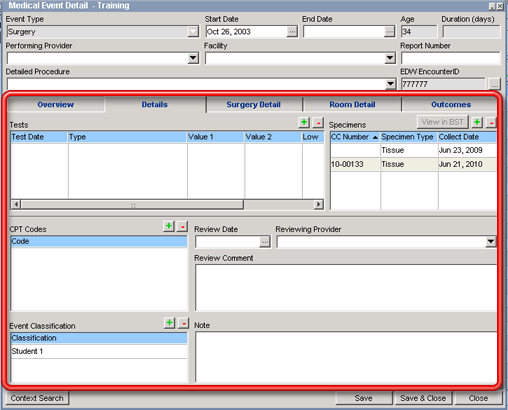
3. Click on the + button above the Specimens grid on that tab. The Add/Link Specimen window will open. Show me the Add/Link Specimen window. See The Add/Link Specimen Window for a description of this window.
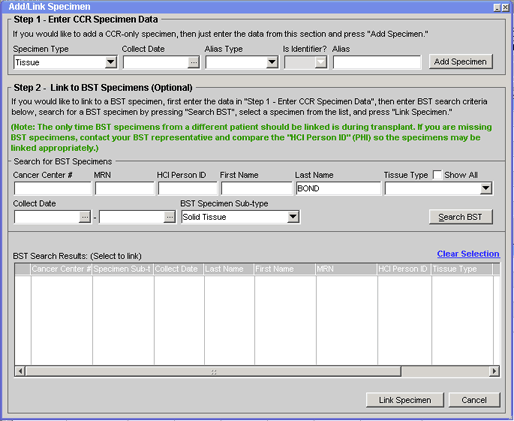
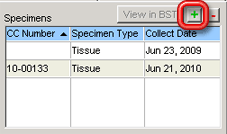
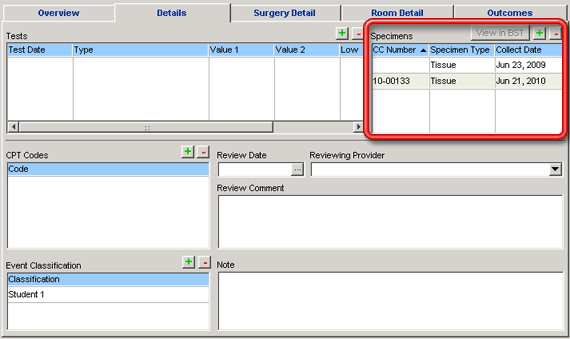
4. Select the Specimen Type in the appropriate field in the Step 1 — Enter CCR Specimen Data data box on the Add/Link Specimen window.
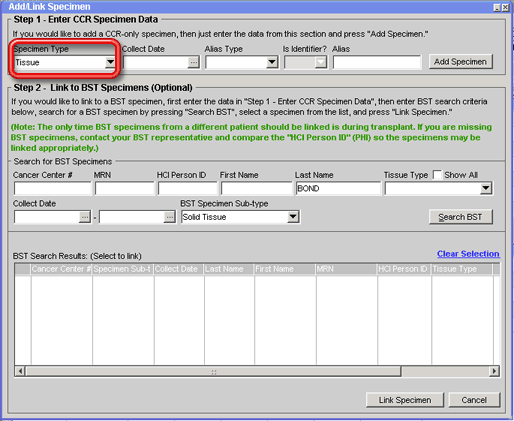
The Collect Date in this data group is not required if you are going to link to an itBioPath record, since this value will be automatically filled in when you establish the link. You may, however, choose to fill in this or the Alias fields to narrow down the number of resulting records that will be found as possible specimens to link to.
5. Enter appropriate search criteria in the fields in the Search for BST Specimens area of the Step 2 — Link to BST Specimens (Optional) data box to search itBioPath's records for appropriate specimens to link to. See The Add/Link Specimen Window for a description of the search criteria fields.
The patient's last name will be automatically entered in the Last Name field and the value that corresponds in itBioPath with the Specimen Type selected (see step 4 above) will be automatically entered in the BST Specimen Sub-type field. (You may edit the Last Name default search value if necessary, but not the value selected in BST Specimen Sub-type.) This criteria may be enough to perform an adequately specific search. If too many records are returned to be useful, you can perform the search again (repeating steps 5 and 6) with additional search criteria to reduce this number.
6. Click on the Search BST button. The BST Search Results: (Select to link) grid will be populated with specimen records from itBioPath that match all of the search criteria entered.
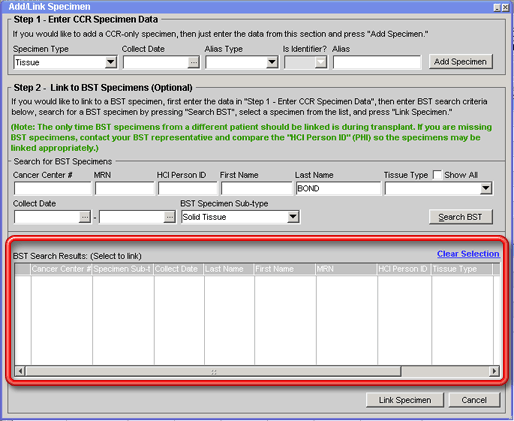
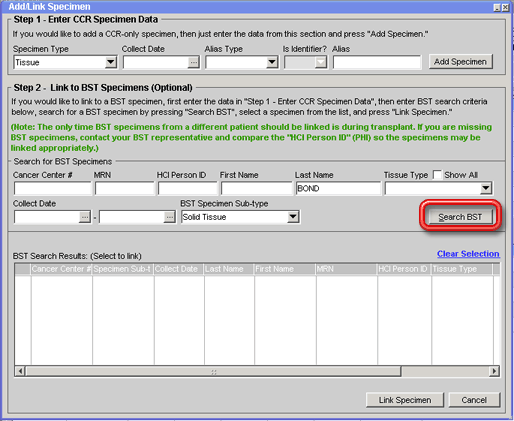
7. Click on the row of the specimen to be linked to the patient record from those returned in the grid. The row will be highlighted in yellow.

8. Click on the Link Specimen button to add/link the selected specimen to the patient record. The specimen will be added to the patient record with a link to the indicated itBioPath record. The Add/Link Specimen window will remain open, but the newly linked specimen will no longer appear in the BST Search Results grid.
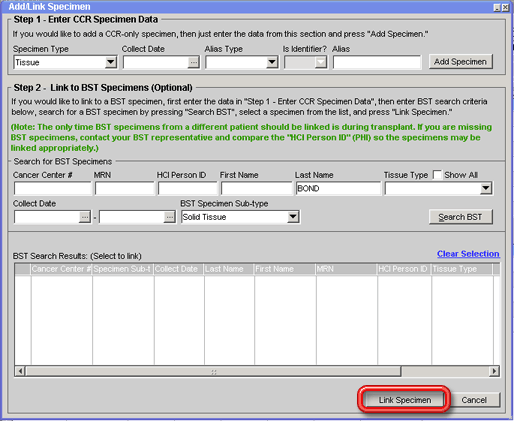
9. Repeat steps 4 through 8 for any additional specimen that might need to be added to the database. (If the additional specimens already appear on the BST Search Results grid, you can simply repeat steps 7 and 8.) If necessary, you may also add some specimens that are not linked to BST records at this point as well — see Adding a Specimen to a Patient Record.
10. When you have added all of the specimens you need to, click the Cancel button to close the Add/Link Specimen window. The newly added specimens will be displayed in the Specimens grid on the Medical Event Detail window and in the Specimens grid on the Labs tab of the corresponding patient detail window.





